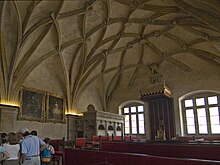Bohemian Diet
You can help expand this article with text translated from the corresponding article in Czech. (November 2019) Click [show] for important translation instructions.
|
Bohemian Diet | |
|---|---|
Unicameral | |
| History | |
| Founded | 6 April 1861 (as a constitutional body) |
| Leadership | |
The Deputy Supreme Marshal of the Kingdom of Bohemia | |
The Provincial Committee | |
| Seats | 214 (until 1848) 241 (from 1861) 242 (from 1882) |
| Elections | |
| Plurality voting (Two-round system) | |
Last election | The 1908 Provincial Elections |
| Meeting place | |
 | |
The Bohemian Diet (
The Diet during the Absolutist Period

In 1471, the Bohemian estates elected the Jagiellon Vladislav II as their king. In 1500, the Land Assembly approved the Vladislav Land Establishment, named after the king, which gave the Bohemian noblemen an extensive share in political co-decision and is also considered to be the oldest written Czech constitution.
The chairman of the assembly was called the
After the defeat of the Bohemian estates in the Battle of White Mountain, Ferdinand II would proclaim in 1627 for Bohemia and 1628 for Moravia the Renewed Regional Code, in which the monopoly position of the states was abolished in favour of the provincial government. Despite these limitations, the Diet and its committees, like the Diets in Austria, remained an effective means of political co-decision. In their meetings, usually once a year, the estates could, through the amount of taxes, resist the lords of the land. All direct and indirect taxes, with the exception of the collection of customs duties, remained within the competence of the estates.[3] The Diet was thus a relic of the estate power rather than an absolutist instrument and even by the 1830s, the diet was again a base for organizing the opposition and a place of political friction.[4]
Only during the reign of Maria Theresa was the strong share of estates in power permanently limited.[5]
The diet was, with the exception of 1784–88 under Joseph II, held without interruption until 1848.[6] At the end of its existence in 1848, the diet had 214 members.
The diet met at Prague Castle until 1801. From 1801 he was based in the Thun Palace in Malá Strana, Prague. This conference location remained the same until 1913. Today the palace is the seat of the Chamber of Deputies of Czechia.
See also
References
- ISBN 9780674025820.
- OCLC 9631955.
- OCLC 9631955.
- OCLC 74270300.
- ^ Karl Bosl: Bohemia as a paradigm of professional representation from the 14th to the 17th centuries. In: Karl Bosl (ed.): Current research problems around the First Czechoslovak Republic. Verlag Oldenbourg, Munich 1969, pp. 9-21
- OCLC 9631955.
